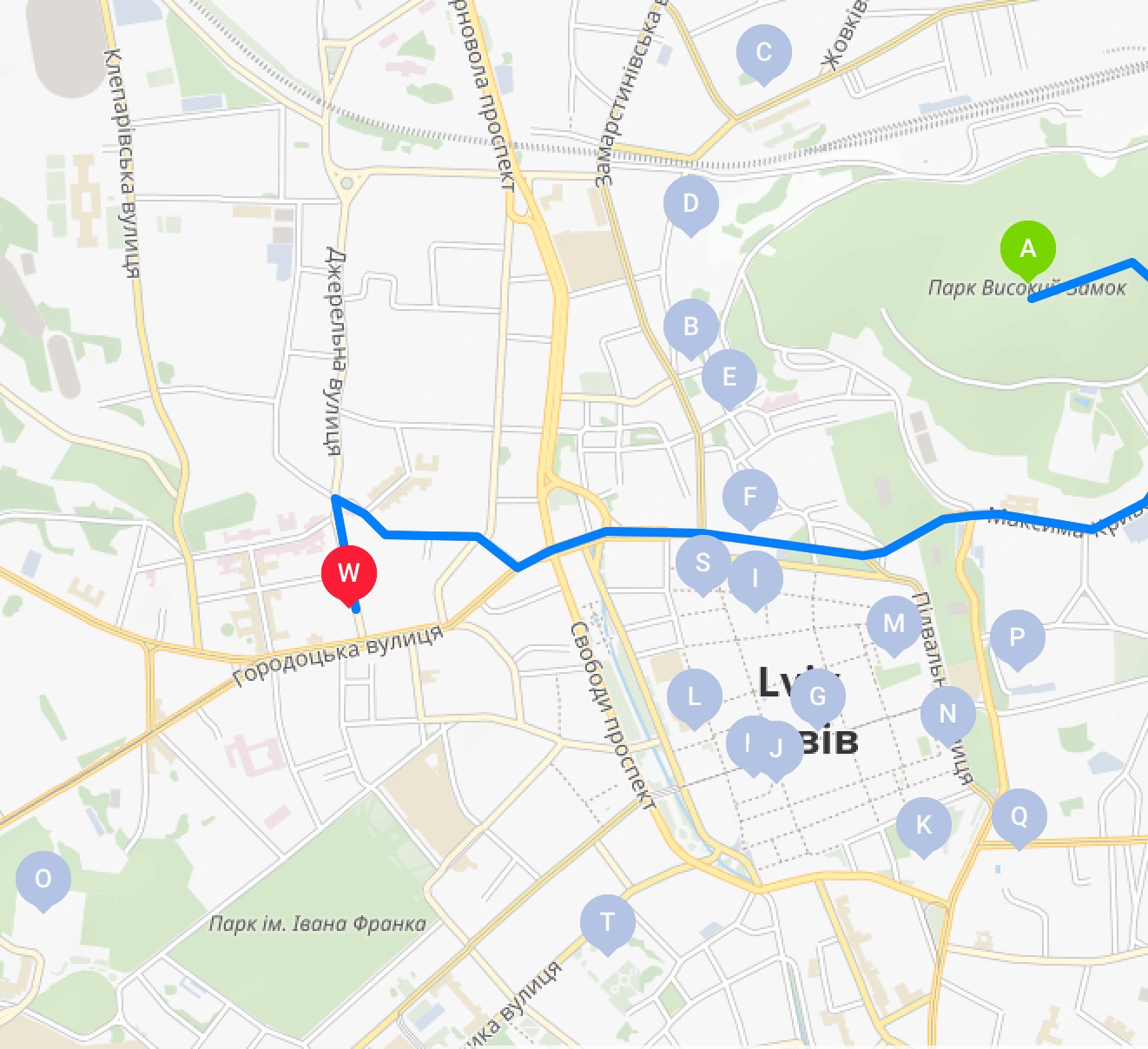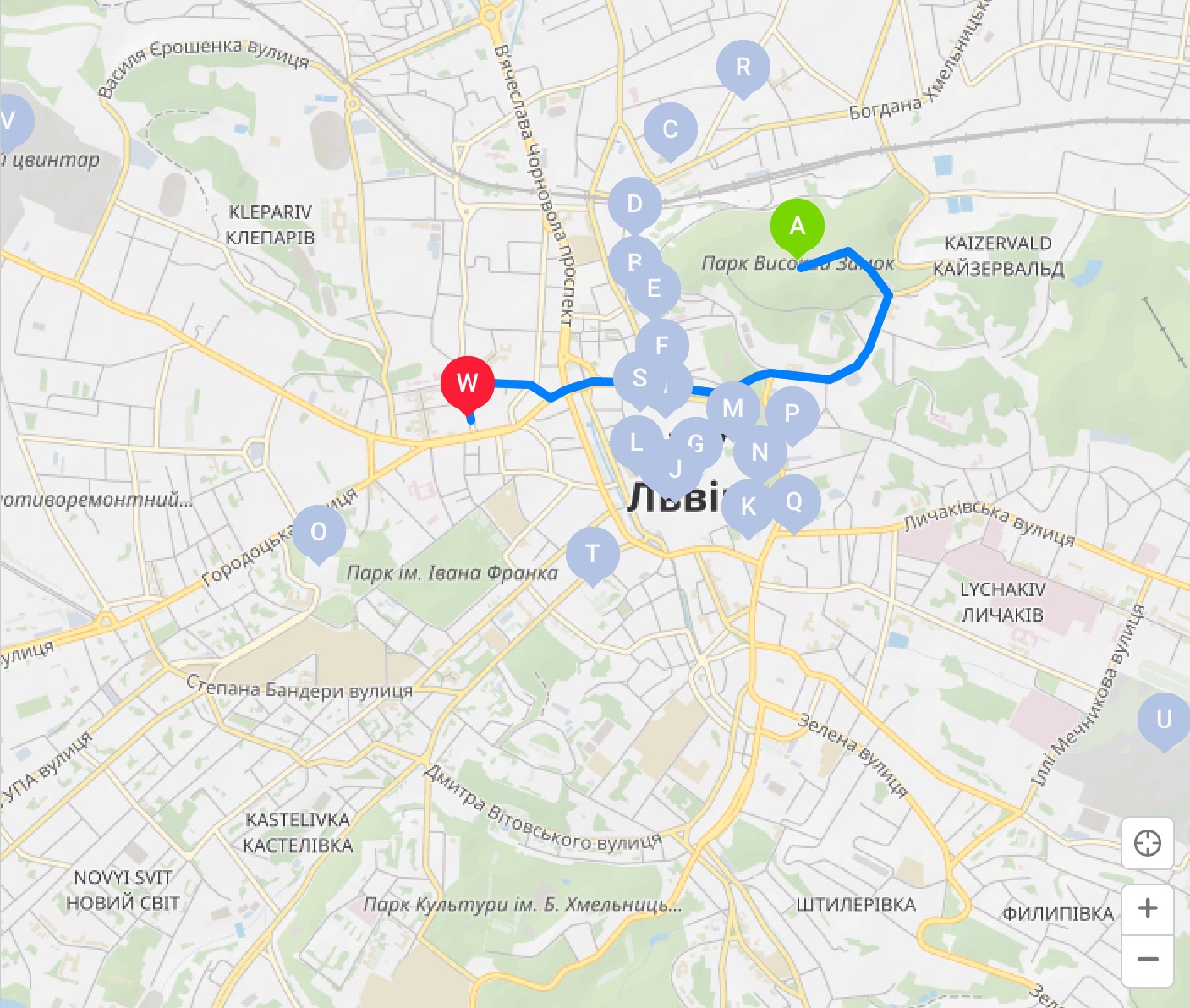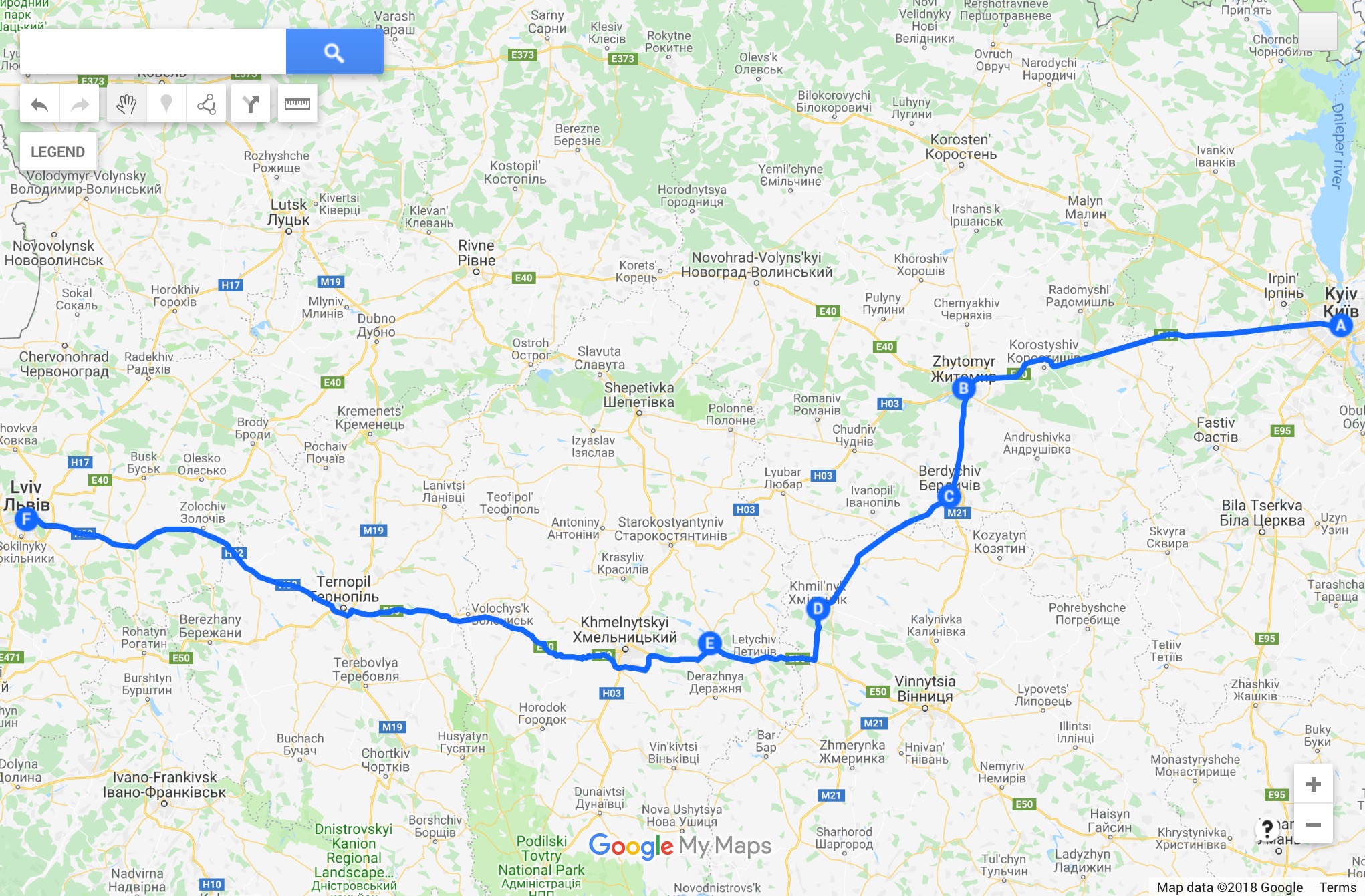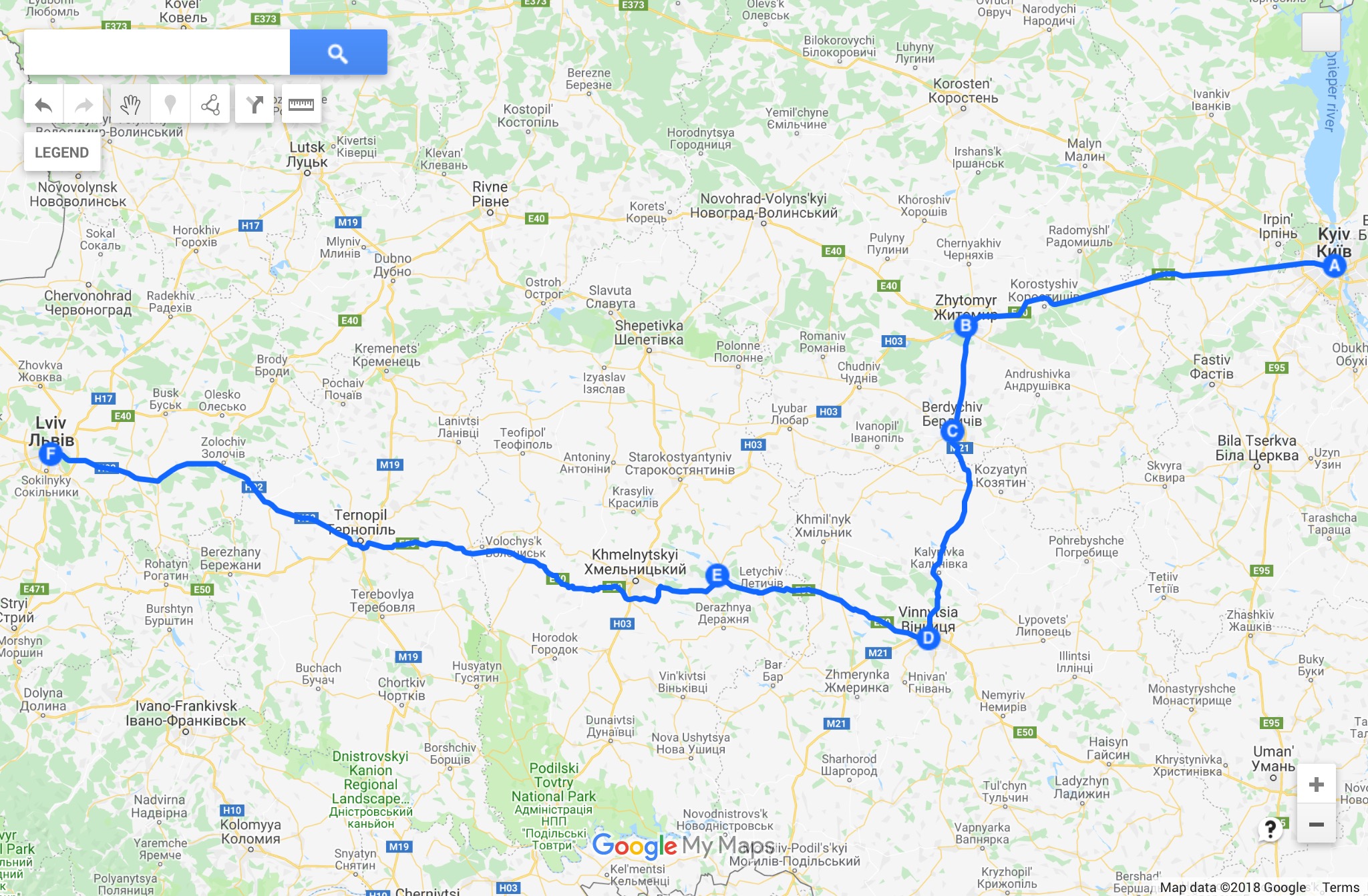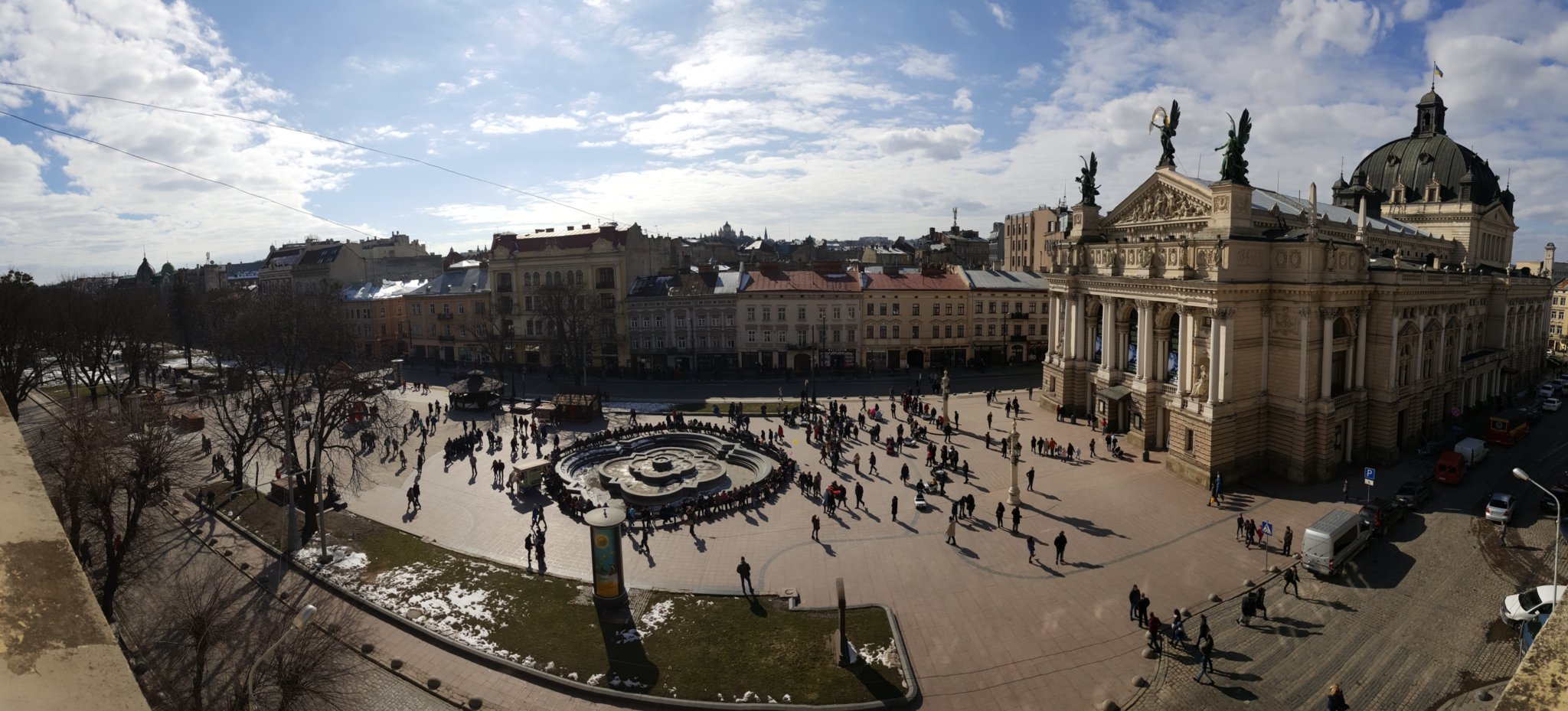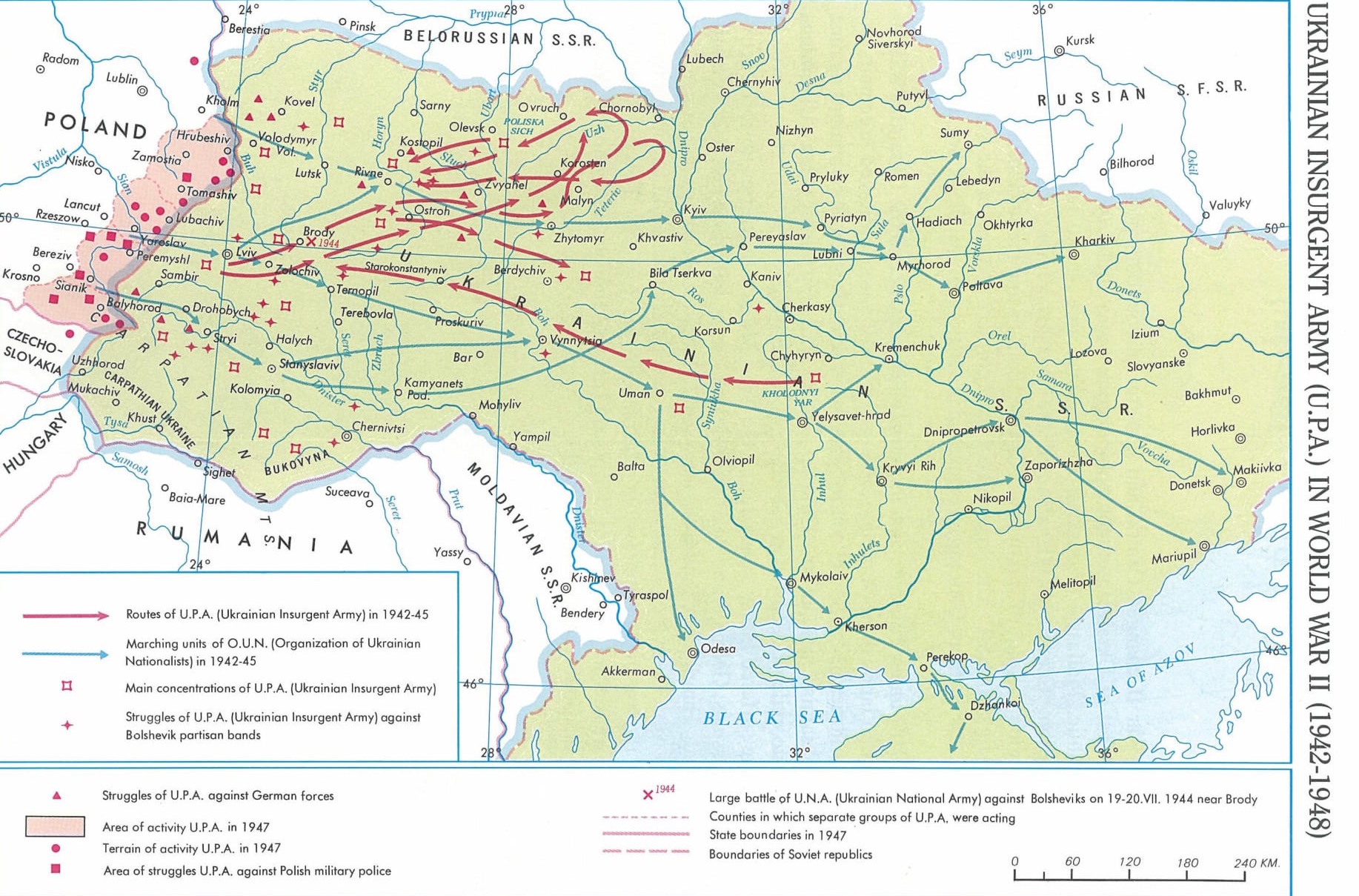Ensemble of the Historic Center of Lviv Old Town for the first view visitors
UNESCO World Heritage Site objecs
A. High Castle and Park
B. St. Nicholas Church
the family church of the Halychyna (Ruthenian) kings
C. St.Paraskeva-Praxedia (Good Friday) Church
contains 1740 inconostasis of the church by Fedor Senkovych
D. St. Onuphrius Church and Basilian Monastery
contains artworks of Lazar Paslavsky and Modest Sosenko
E. St.John the Baptist Church (today – Museum of Lviv Ancient relics)
was dedicated to the Hungarian wife of King Leo,
Constance, a daughter of King Béla IV
F. Church of Snowy Mary (today – Our Lady of Perpetual Help Church)
the church of German colonists of the city
G. Ensemble of Ploshcha Rynok (Market Square)
contains Lviv Rathaus (center) and square perimeter of housings surrounding it
H. Ensemble of the Church of Assumption of the Blessed Virgin Mary
includes Chapel of Three Prelates and Korniakt's Tower
I. Ensemble of Armenian Church
includes a belfry, a column with statue of St.Christopher, a building of former Armenian bank, a palace of the Armenian archbishops, Benedictine Armenian convent
J. Ensemble of Latin Metropolitan Cathedral
beside the cathedral of St. Mary includes Boim Chapel and Kampians' Chapel
K. Ensemble of Bernardine Cathedral and Monastery (now Church of St. Andrew),
includes cathedral, monastery, belfry, rotunda, decorative colon, and defensive walls
L. Ensemble of the Jesuit Cathedral and Collegium
M. Ensemble of Dominican Church and Monastery (now the Church of the Holy Eucharist)
beside the church includes monastery and belfry
N. Lviv Arsenal Museum
City's fortifications include the City's Arsenal, the Gunpowder Tower, the Turners and Ropemakers' Tower, the Royal Arsenal, a bastion of lower defense wall
O. St. George’s (St. Yura) Cathedral
includes the Metropolitan's Palace, capitular houses, belfry, and fence with two gates (Market's and City's)
Old Town landmarks that are not part of the World Heritage Site:
P. Church and Nunnery of Carmelites, the Barefooted (today – Church of Purification)
Q. Johann Georg Pinzel Sculpture Museum of Sacral Baroque Sculpture
former Church of Poor Clares
R. St.Martin Church (today – Baptist Church)
S. Church of Transfiguration
T. Potocki Palace (currently a residence of the President of Ukraine)
U. Lychakiv Cemetery
V. Yaniv Cemetery
W. Lviv Opera
Duration from Kyiv to Lviv by train - 5 - 12 hours.
Variants of routes from Kyiv to Lviv by car:
1) 550 km
Kyiv - Zhytomyr - Novohrad-Volyns'kyi - Korets' - Dubno (Tarakanivskyi Fort) - Brody - Oles'ko - Lviv
2) 600 km
Kyiv - Zhytomyr - Berdychiv - Khmilnyk - Medzhybizh - Lviv
3) 640 km
Kyiv - Zhytomyr - Berdychiv - Vinnytsia - Medzhybizh - Lviv
Lviv is the biggest city of the Western Ukraine, with a population of about 750,000; located on about 550 km from Kyiv (by the shortest route).
HALYCH-VOLYNIAN KINGDOM IN THE XIII AND XIV CEN.
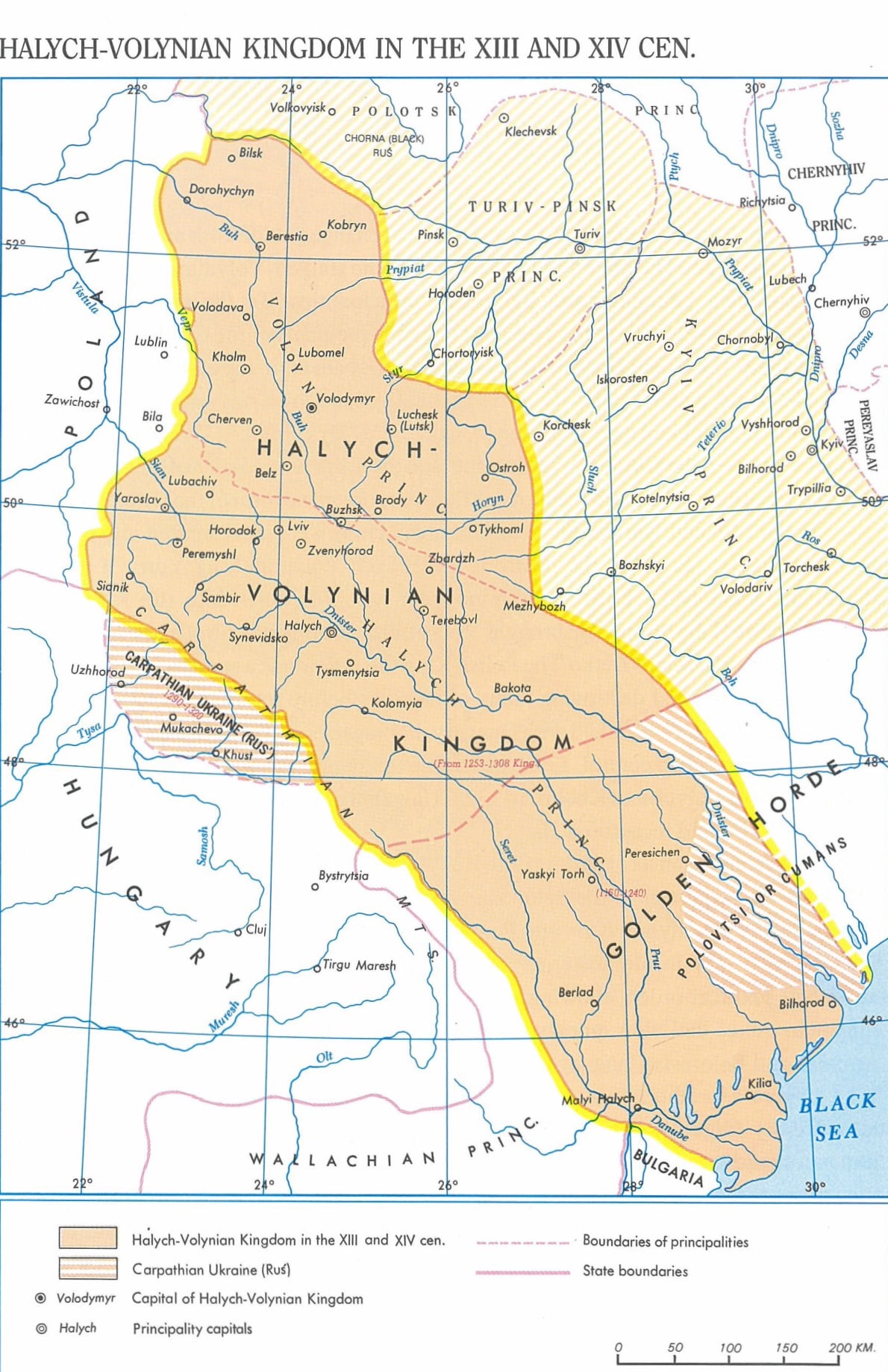 The principalities of Halych (Galicia) and Volyn were united for the first time under Prince Roman Mstyslavych in 1199. He successfully defended the Halych-Volynian state against attacks from the Baltic tribes to the north and the Polovtsi (Cumans) to the south. He died in 1205, leaving two young sons, Danylo and Vasylko.
The principalities of Halych (Galicia) and Volyn were united for the first time under Prince Roman Mstyslavych in 1199. He successfully defended the Halych-Volynian state against attacks from the Baltic tribes to the north and the Polovtsi (Cumans) to the south. He died in 1205, leaving two young sons, Danylo and Vasylko.
The powerful Halych boyars (wealthy and influential landowners) refused to recognize Roman's minor sons as successors to the throne. Instead, they invited the three sons of the Chernyhiv prince, Ihor Svyatoslavych, to rule in Halych. The rulers refused to share power with the boyars and a bloody struggle took place, ending with the expulsion of the Ihorevychi rulers. Poland and Hungary, taking advantage of the situation, invaded Halych in 1214, proclaiming the young Hungarian Prince Kalman as King of Halych.
Danylo Romanovych (son of Roman) regained the Volyn throne in 1221. He then set out to regain the throne of Halych. In 1235, aided by the Novhorod Prince Mstyslav Udatnyi, he succeeded in removing the Hungarians from Halych, but the Hungarians and Poles remained a threat until 1245 when Danylo finally defeated them near the city of Yaroslav.
Finally, Danylo had succeeded in reclaiming his father's realm. He remained in Halych while his younger brother, Vasylko, ruled in Volyn. Although divided between the two brothers, the principality of Halych-Volyn, politically and administratively, functioned as a single entity, with Danylo effectively at the helm.
Like the other princes, Danylo was forced to pay homage to and accept the overlordship of the Golden Horde. Unhappy with the situation, Danylo approached Pope Innocent IV, offering to place his realm under the jurisdiction of Rome, in return for papal aid in mounting a crusade against the Mongols. In 1253 Danylo was crowned king in Dorohychyn by a papal representative and the Halych-Volynian Kingdom came into existence. The Mongols, learning of Danylo's political maneuverings, attacked and forced him to destroy all his fortifications.
After the death of Danylo in 1264, his son Lev (1264-1301) ascended the throne. Maintaining stability at home, Lev embroiled himself in the politics of western Europe, at one point aspiring to the Polish throne. He was succeeded by his son Yuriy, whose two sons, Andriy and Lev were the last of the Romanovych dynasty to rule the Halych-Volynian State. In 1323 a Polish cousin of the Romanovychi, Boleslaw of Mazowia, ascended the throne. He took the name of Yuriy and converted to Orthodox Christianity, ruling until 1340.
Lviv, one of the oldest and most beautiful towns in the Ukraine, lies in the foothills of the Carpathians, on the watershed of the rivers Bug and Dniester, approximately 500 km to the west of Kiev and 70 km from the frontier with Poland. Lvov has regular rail services with Poland, Romania, Czech, Austria and Hungary, and also with many centres of tourism in Ukraine. The town, Is five hours journey from the frontier check-point at Chop (266 km). It takes about 7 hours 30 minutes from Lviv to Kyiv by train (627 km), and the distance by road is 550km.
Lviv was founded in 1256 by the Ukrainian prince Danylo Galytskyi as a fortress to defend his lands against raids by nomad tribes from the east, and was named in honour of his son Lev (Leo). In the Middle Ages, Lvov was one of the enlightened towns of Europe. In 1574 the first Ukrainian and Russian printer Ivan Fedorovych ( known in Muscovy and Russia as Fyodorov) set up a printing-press here. In the mid-sixteenth century the first institution of higher education in the Ukraine, the "Lvov fraternity'' was started in Lvov, and by the seventeenth century there were already two establishments of higher education in the town, one of which became the university in 1661.
In 1901-1903 the illegal Leninist newspaper Iskra (Spark) was transported to Russia via Lvov. After the Bolshevik October Revolution in Russia (1917) in the course of the intervention against Soviet Russia, Lvov was seized by the forces of bourgeois Poland.
In September 1939 Lvov became a part of the Soviet Ukraine, and since that time it has been a regional centre in the Ukrainian SSR. The town was badly damaged during the Second World War.
Liberated from nazi occupation in 1944, in the postwar years it developed into one of the Ukraine's important industrial centres. Lvov's enterprises supply the Soviet Union with buses, TV sets, metal-cutting lathes, medical and telegraphic equipment. The production of farm machines and the glass industry are well developed in the town. Besides one of the oldest universities in Europe, Lvov has another nine institutions of higher education. In the town there is the Ivan Franko Academic Opera and Ballet Theatre, the Ukrainian Theatre, and the Philharmonic Society. The choir Trembita is the most popular of the folk song and dance companies.
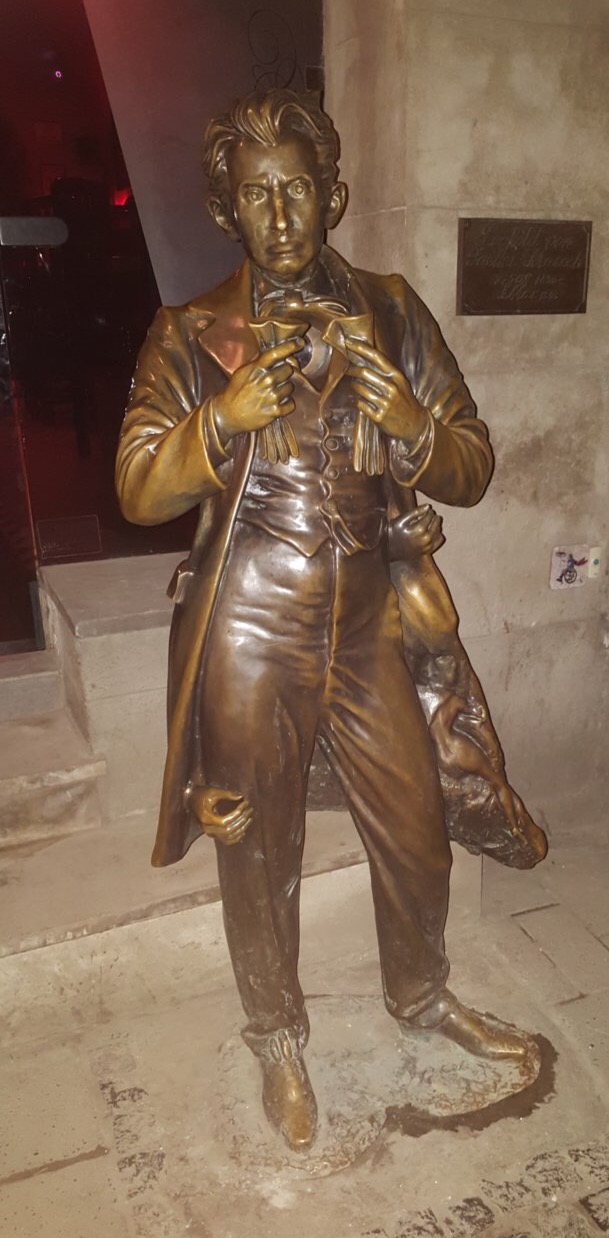 Lviv has its own distinctive style of architecture. In the sixteenth century the presence of a large Italian trading colony in the town left its mark on the building work. In the seventeenth century the Italian Renaissance style changed to Baroque. In the eighteenth century Rococo from Poland prevailed, followed by German classicism in the nineteenth century. The town even has an Armenian cathedral, which was the church of the Armenian merchants' colony. Interesting buildings have also been erected in the last ten to twenty years. It is best to begin your sightseeing tour of the town on the former Knyazha Gora (Prince's Hill) where Prince Danylo Galytsky built his fortress. The ruins of the fortress have survived here in Vysoky Zamok (High Castle) Park. From here your tour will take you along Bohdan Khmelnytsky street to the centre of the old town. On the way you will see three old churches, the Church of St. Nicholas (thirteenth century), the Onufriyevska Church (1518) where the first printer Ivan Fyodorov is buried, and the Pyatnytska (Good Friday) Church (1645). In the centre of the old town there is Ploshcha Rynok (Market Square) which is lined by buildings from the fifteenth-nineteenth centuries. The most impressive among them are the former Town Hall (1827), the palace in Renaissance style, and the so-called Chorna Kamianytsia, a complex of sixteenth-century dwellings. Many valuable historical and architectural monuments are extant the districts adjacent to the square. Thus, in Vicheva Street there is the former Benedictine Convent and Cathedral (1595-1628) in Italian-Byzantine style; in Virmenska (Armianska, Virmenian) street, the Armenian Cathedral (1363); in Stavropihiiska street, the Dominican Church (1764) in Baroque style decorated with an enormous number of sculptures; in Pidvalna Street, the Royal Arsenal (eighteenth century) and the Town Arsenal (sixteenth century), the Powder Tower (1554); in Ivan Fedorov street there is the Printing-house of the Stavropichiiske fraternity (seventeenth-nineteenth centuries), and on the street intersecting it, Ruska (Russian) street - the Russian Orthodox Church of the Dormition (1630), the Chapel of the Three Prelates (1578), and the house of Komyakt (1572). To the south of Market Square, there is the Bernardine Church, which has monks' cells (1600-1630). To the southwest of Market Square one of the largest groups of cult buildings in old Lviv is extant. This is the Latin Cathedral (1360-1480) and the chapels of Kampiano and Boimi adjacent to it (sixteenth century) which are richly decorated with stone-carving and sculptures.
Lviv has its own distinctive style of architecture. In the sixteenth century the presence of a large Italian trading colony in the town left its mark on the building work. In the seventeenth century the Italian Renaissance style changed to Baroque. In the eighteenth century Rococo from Poland prevailed, followed by German classicism in the nineteenth century. The town even has an Armenian cathedral, which was the church of the Armenian merchants' colony. Interesting buildings have also been erected in the last ten to twenty years. It is best to begin your sightseeing tour of the town on the former Knyazha Gora (Prince's Hill) where Prince Danylo Galytsky built his fortress. The ruins of the fortress have survived here in Vysoky Zamok (High Castle) Park. From here your tour will take you along Bohdan Khmelnytsky street to the centre of the old town. On the way you will see three old churches, the Church of St. Nicholas (thirteenth century), the Onufriyevska Church (1518) where the first printer Ivan Fyodorov is buried, and the Pyatnytska (Good Friday) Church (1645). In the centre of the old town there is Ploshcha Rynok (Market Square) which is lined by buildings from the fifteenth-nineteenth centuries. The most impressive among them are the former Town Hall (1827), the palace in Renaissance style, and the so-called Chorna Kamianytsia, a complex of sixteenth-century dwellings. Many valuable historical and architectural monuments are extant the districts adjacent to the square. Thus, in Vicheva Street there is the former Benedictine Convent and Cathedral (1595-1628) in Italian-Byzantine style; in Virmenska (Armianska, Virmenian) street, the Armenian Cathedral (1363); in Stavropihiiska street, the Dominican Church (1764) in Baroque style decorated with an enormous number of sculptures; in Pidvalna Street, the Royal Arsenal (eighteenth century) and the Town Arsenal (sixteenth century), the Powder Tower (1554); in Ivan Fedorov street there is the Printing-house of the Stavropichiiske fraternity (seventeenth-nineteenth centuries), and on the street intersecting it, Ruska (Russian) street - the Russian Orthodox Church of the Dormition (1630), the Chapel of the Three Prelates (1578), and the house of Komyakt (1572). To the south of Market Square, there is the Bernardine Church, which has monks' cells (1600-1630). To the southwest of Market Square one of the largest groups of cult buildings in old Lviv is extant. This is the Latin Cathedral (1360-1480) and the chapels of Kampiano and Boimi adjacent to it (sixteenth century) which are richly decorated with stone-carving and sculptures. 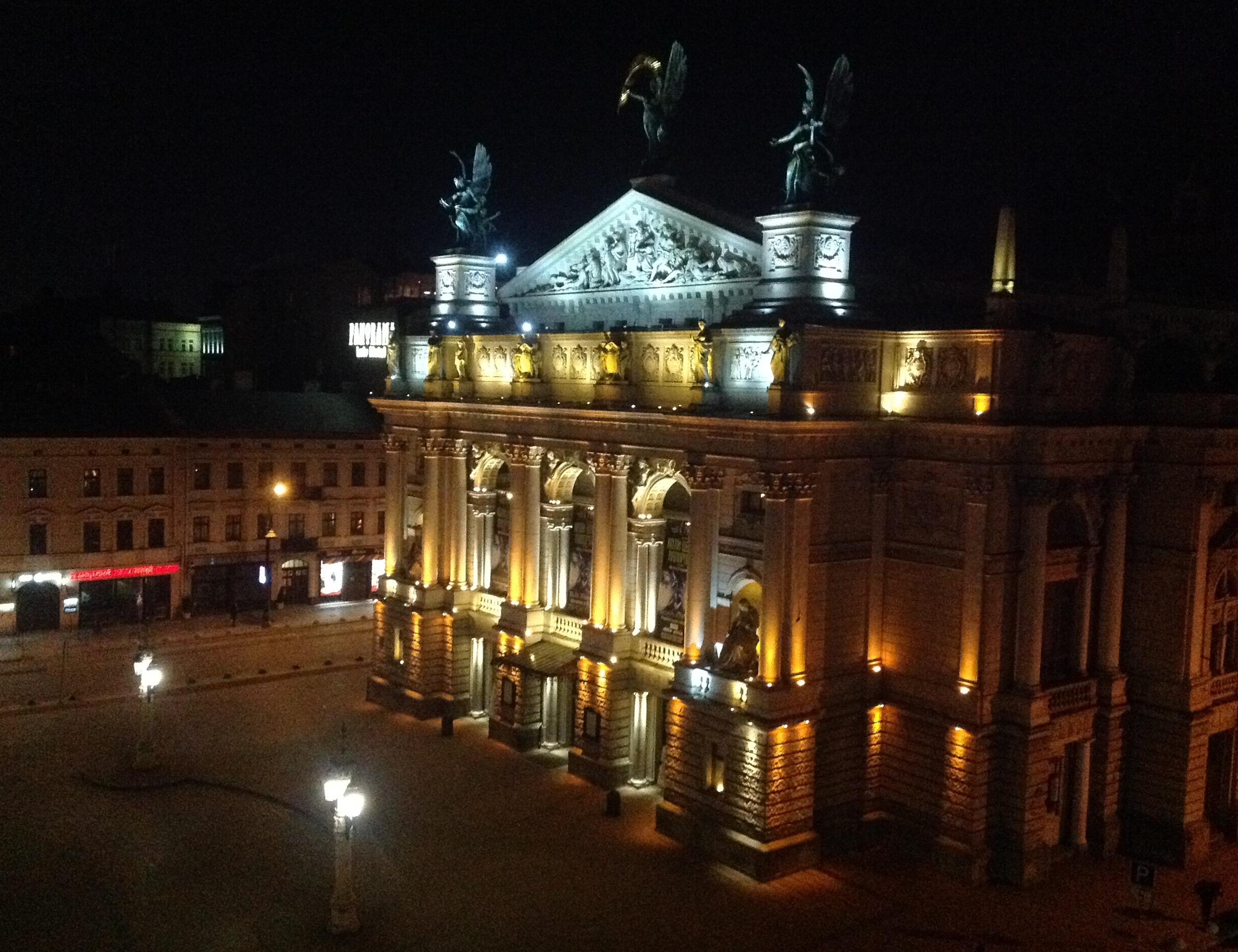 Further towards the southwest lies Ploshcha Mitskevycha (Mickiewicz Square), a small square surrounded by old buildings. In the middle of the square stands a statue of Adam Mickiewicz, the great Polish poet (1905). Lvov's main thouroughfare, Prospect Svobody (Freedom Avenue), leads out of Mickiewicz Square to the north. At the opposite end there is the Opera and Ballet Theatre whose facade is reminiscent of that of the Paris Opera. Enrico Caruso and other famous opera singers frequently sang here. There are quite a few monuments in Lvov recalling the events of the Great Patriotic War: a tank on a pedestal, a monument to the Soviet soldiers who liberated Lviv in 1944. Opposite it on Glory Hill there is a memorial complex consisting of Triumphal Gates, the eternal flame, common and individual graves, and sculptural compositions that create a solemn sorrowful ensemble dedicated to the heroes who fell in the Great Patriotic War. To the southwest of Mickiewicz Square in Grabovsky Street towers a grey fortress structure, the Citadel. In 1941 there was a nazi concentration camp where 140,000 people died. A Monument of Glory to the Soviet Army has been erected in Bogdan Khmelnytsky Park. Lvov is one of the greenest towns in the Ukraine. The most luxuriant of its parks is the Stryiskyi Park laid out in 1876. The lower part of the park which contains a collection of rare trees and shrubs is crossed by straight decorative alleys, while the upper part contains virgin forest. On the southern edge of the Stryiski Park, at 152 Ivan Franko street, stands a wooden house with an attic and a tiled roof where the outstanding Ukrainian author and playwright Ivan Franko lived from 1902 to 1916. Now it houses a Literary Memorial Museum. Of the other museums in Lvov mention should be made of the History Museum, the Museum of the History of the Troops of the Carpathian Military District, the Museum of Ukrainian Art, which has a fine collection of paintings ranging from fourteenth-century icons to modern canvases; and the Picture Gallery with a unique collection of paintings by Austrian and Polish artists of different centuries.
Further towards the southwest lies Ploshcha Mitskevycha (Mickiewicz Square), a small square surrounded by old buildings. In the middle of the square stands a statue of Adam Mickiewicz, the great Polish poet (1905). Lvov's main thouroughfare, Prospect Svobody (Freedom Avenue), leads out of Mickiewicz Square to the north. At the opposite end there is the Opera and Ballet Theatre whose facade is reminiscent of that of the Paris Opera. Enrico Caruso and other famous opera singers frequently sang here. There are quite a few monuments in Lvov recalling the events of the Great Patriotic War: a tank on a pedestal, a monument to the Soviet soldiers who liberated Lviv in 1944. Opposite it on Glory Hill there is a memorial complex consisting of Triumphal Gates, the eternal flame, common and individual graves, and sculptural compositions that create a solemn sorrowful ensemble dedicated to the heroes who fell in the Great Patriotic War. To the southwest of Mickiewicz Square in Grabovsky Street towers a grey fortress structure, the Citadel. In 1941 there was a nazi concentration camp where 140,000 people died. A Monument of Glory to the Soviet Army has been erected in Bogdan Khmelnytsky Park. Lvov is one of the greenest towns in the Ukraine. The most luxuriant of its parks is the Stryiskyi Park laid out in 1876. The lower part of the park which contains a collection of rare trees and shrubs is crossed by straight decorative alleys, while the upper part contains virgin forest. On the southern edge of the Stryiski Park, at 152 Ivan Franko street, stands a wooden house with an attic and a tiled roof where the outstanding Ukrainian author and playwright Ivan Franko lived from 1902 to 1916. Now it houses a Literary Memorial Museum. Of the other museums in Lvov mention should be made of the History Museum, the Museum of the History of the Troops of the Carpathian Military District, the Museum of Ukrainian Art, which has a fine collection of paintings ranging from fourteenth-century icons to modern canvases; and the Picture Gallery with a unique collection of paintings by Austrian and Polish artists of different centuries.
Ukrainian insurgent army (U.P.A.) in World War II (1942-1948)
Knyshi (Pies)
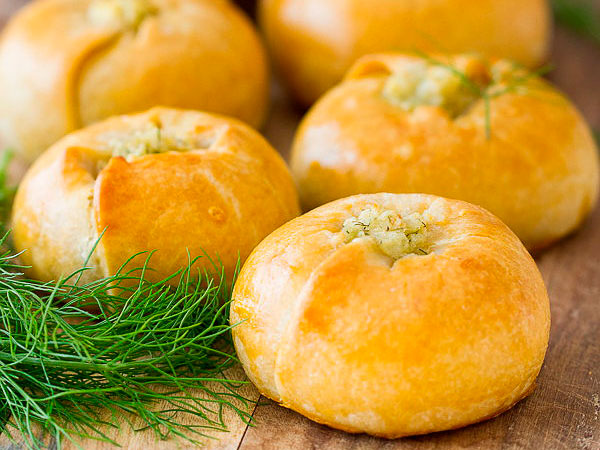 Sift the flour. Mix the yeast with sugar, add half a cup of lukewarm water and leave in a warm place until the yeast has risen. Make a hole in the heap of flour and pour in the remaining lukewarm water and the yeast. Stir the dough carefully and leave in a warm place to rise. When the dough has doubled in size, add salt and knead the dough thoroughly. Leave it to rise again.
Sift the flour. Mix the yeast with sugar, add half a cup of lukewarm water and leave in a warm place until the yeast has risen. Make a hole in the heap of flour and pour in the remaining lukewarm water and the yeast. Stir the dough carefully and leave in a warm place to rise. When the dough has doubled in size, add salt and knead the dough thoroughly. Leave it to rise again.
Pinch off a piece of dough the size of a large fist or two, make a ball, put it on the baking tray and pat to flatten. Sprinkle the pastry with salt and oil. Pierce the pastry's edges with a greased spoon. The number of holes - five or seven - depends on the size of the pie. Get a hold of each strip and pull them to the center of the pie. Press the strips together firmly. Brush the pie with oil. Bake in the oven at a middle temperature of about 200-C. Carol-singers and other visitors were offered knyshy in abundance.
(3,5 cups rye four, 1,5 cup wheal flour, 40 g yeast, 4 tablespoons sugar, salt, 1/2 liter lukewarm water, oil (to grease the baking tray))


